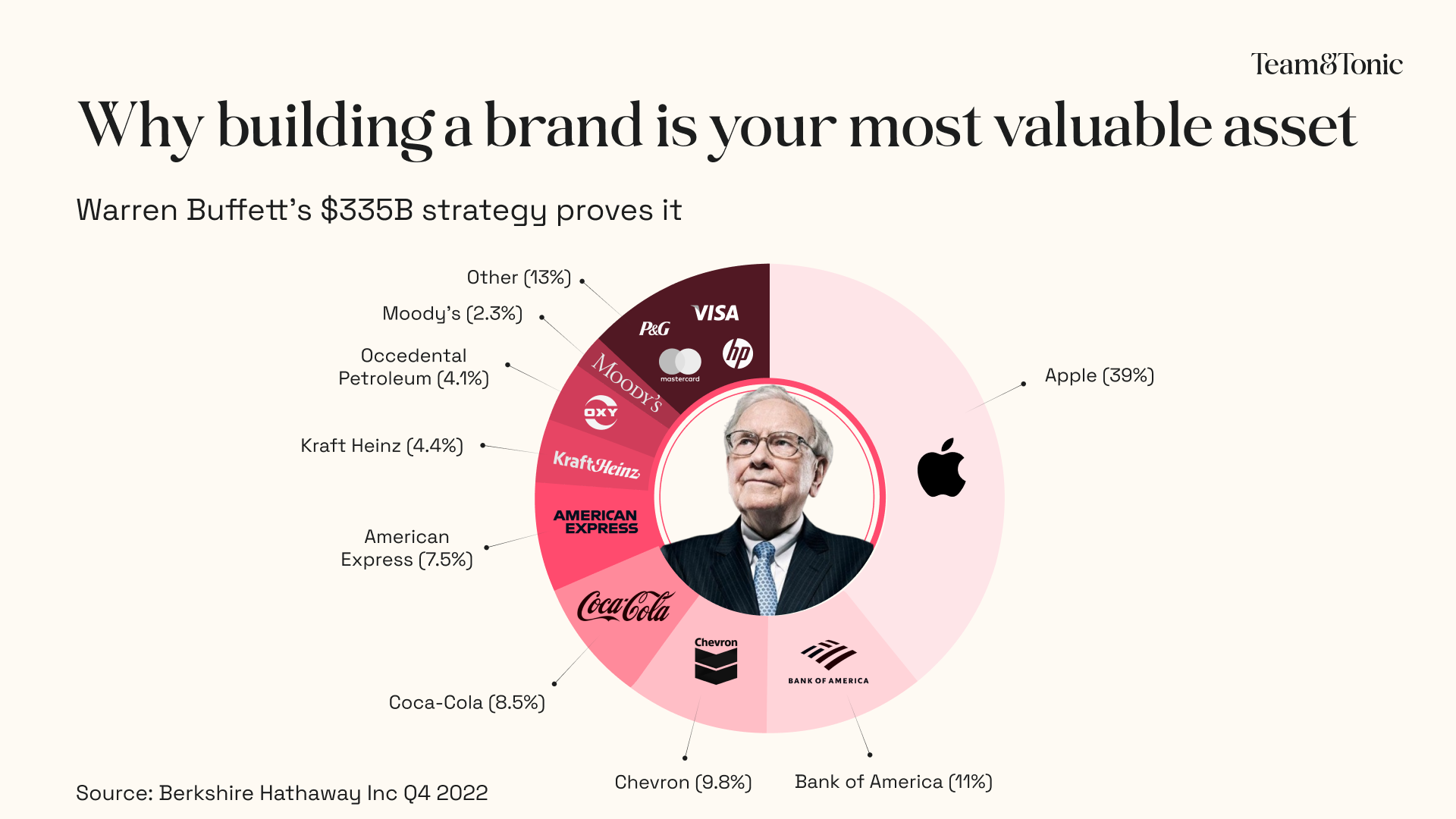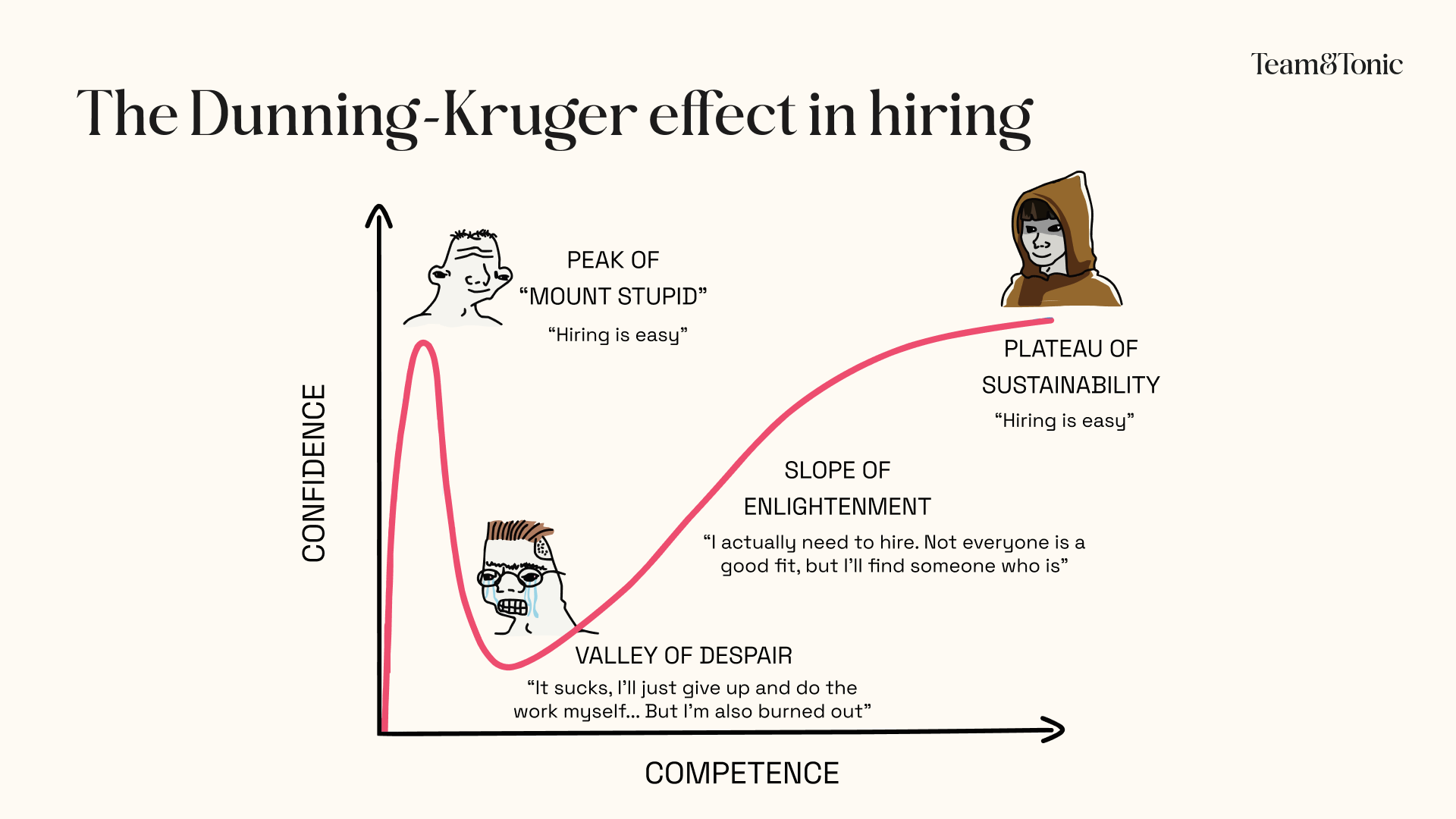How to Build a Brand That Sells and Scales?
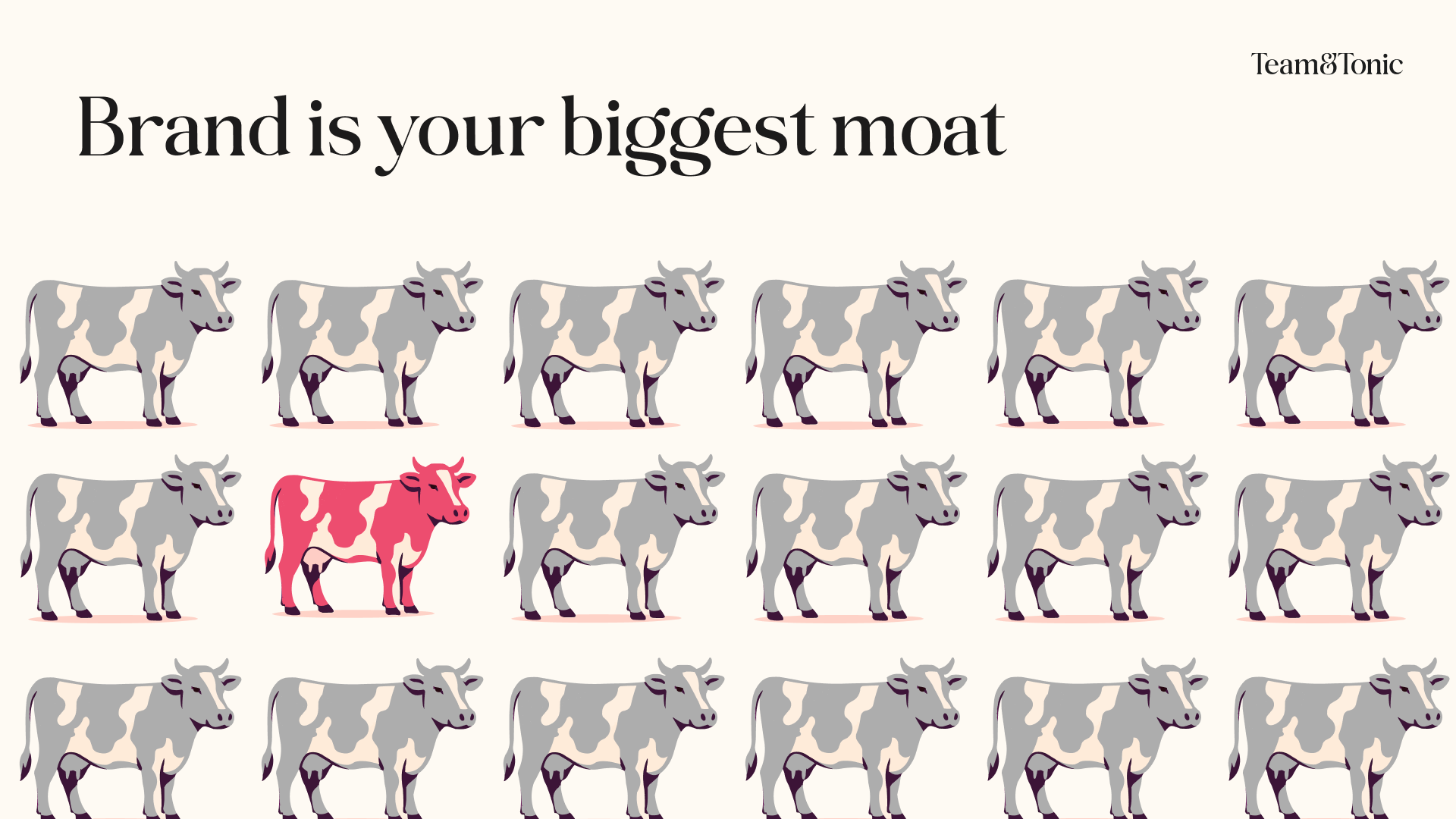
Why Branding Matters More Than Ever
A few years ago, a founder I worked with built a brilliant product.
It solved a real problem.
Customers loved it.
Revenue was growing fast.
Then came the copycats: Clones with similar features, cheaper pricing, and better marketing.
Within months, his product started to feel… replaceable.
If you’re starting to feel the same: competition rising, price comparisons becoming daily headaches, and differentiation fading, this article is for you.
What we’re going to cover in this article might change the way you think about scaling:
Because your product isn’t your moat. Your brand is.
And it’s one of the most overlooked growth levers in tech.
Ask experienced founders or sharp investors, they’ll tell you the same:
Brand is what makes people choose you, trust you, and stay loyal when the market gets crowded.
So if scaling feels harder than it used to… Let’s talk about what brand really is and how to use it to scale.
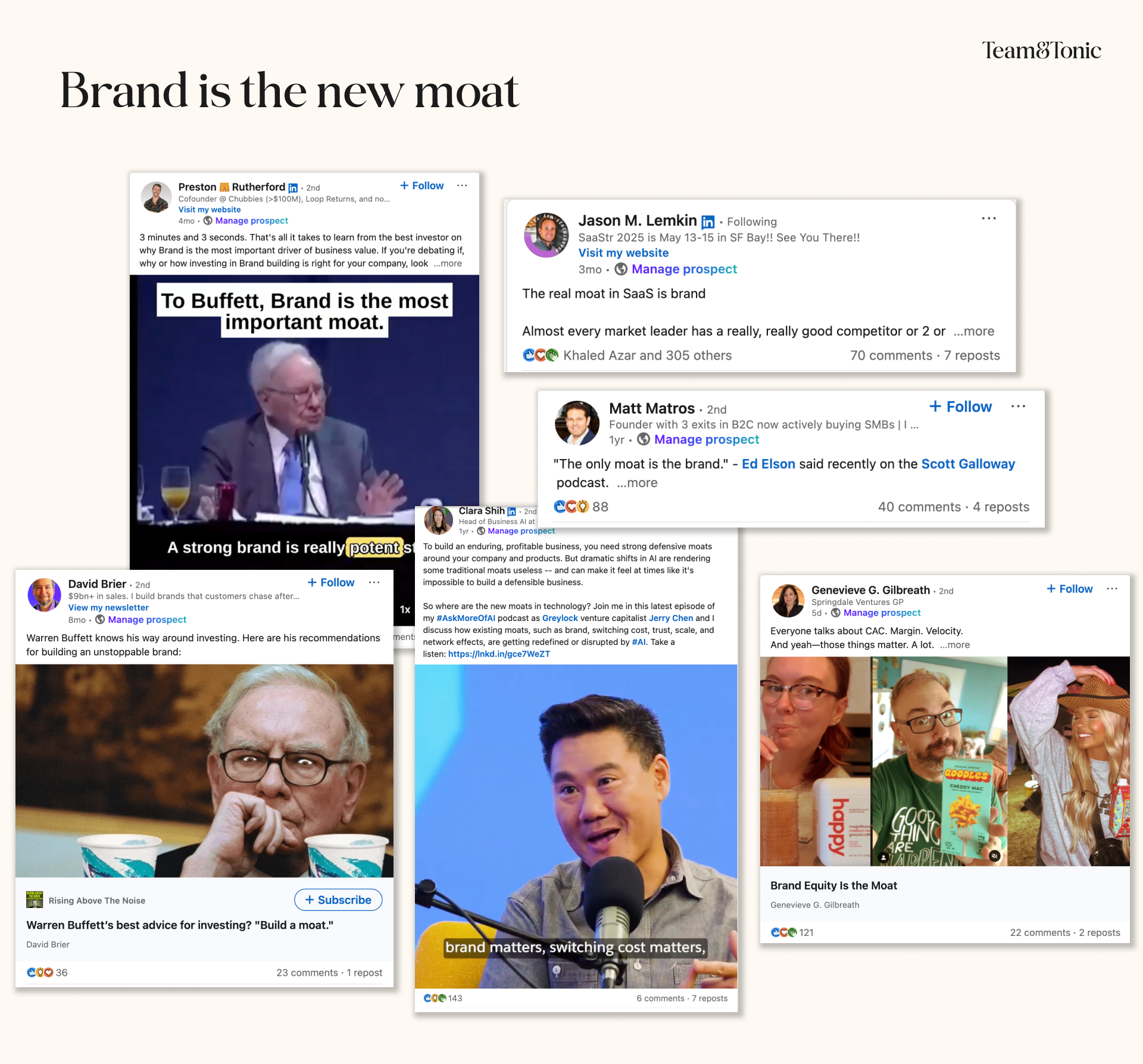
Like many founders, I asked myself the following question for a very long time:
“Why should I care about something so abstract, something no one can clearly explain or tie to revenue? Does brand even drive growth?”
I always knew branding mattered. After all, the best B2B and B2C companies all invest in it. What I didn’t know was why it mattered, and whether my company truly needed it.
When I got started in this quest, I just asked these questions to any designer or creative director. But no one could clearly explain the relationship between branding and business.
Over time, I got to realize that 99% of designers only understand aesthetics, not how their work can actually bring business growth.
So tired of not finding answers. So here’s what I did:
- I read over 30 books on the topic.
- Built a recruiting system for 2 years to find exceptional designers, creative directors, and brand strategists.
- Connected with founders who could clearly articulate the relationship between branding and growth, and how they use it as a lever for their business.
And that’s when I got to understand why the biggest companies spend millions (sometimes even billions) on branding.
In this article, I’ll share everything you need to know about the fundamentals of branding: why it’s so powerful, how it works, how it can boost your company’s visibility, and how you can put it into action.
I’m excited to share with you these lessons so you can skip the struggles I went through, save 2 years of trial and error, and gain a clear, actionable understanding of branding. If you are committed to it, you can start building a real brand right now (I explain that at the end of this article).
So let’s get started!
How Does Branding Actually Work? And What No One Tells You.
If you want to sell, find contrast.
Imagine that you sneeze in the middle of Times Square. No one cares.
But sneeze in a silent library? Every head turns.
The same concept applies to your marketing, sales, and branding.
Most startups today are sneezing in Times Square. They're pouring money into ads, campaigns, content… but still being ignored.
Why? Because they blend in. No contrast. No story. No spark.
We all know that attention is the new gold.
But the question is, how do you actually get attention?
Here’s the part no one tells you:
Most startups today rely solely on marketing activities. And while marketing alone works, without branding, it’s incomplete and far less effective.
Getting people to buy is not just about showing more impressions. It’s also about creating a deep emotional connection. Making your message stick and your company unforgettable.
It’s what makes someone stop scrolling, feel something, and think, “This is for me.”
And if you manage to tap into that emotion, you’ll get customers faster, reduce your CAC (cost of acquisition per customer), and build trust that lasts.
So if that’s the holy grail… How do you actually get there?
Understanding the gap
To truly understand how branding works, we need to start with a simple question:
Why do people buy anything at all?
At the core, every person wakes up each day chasing a better version of their reality.
They go to work, make decisions, and spend money, not just for survival, but to move closer to something they want.
That’s how the economy works. That’s why money is exchanged.
That’s why businesses exist.
And that’s your job as a founder or marketer:
To help people move from where they are to where they want to be.
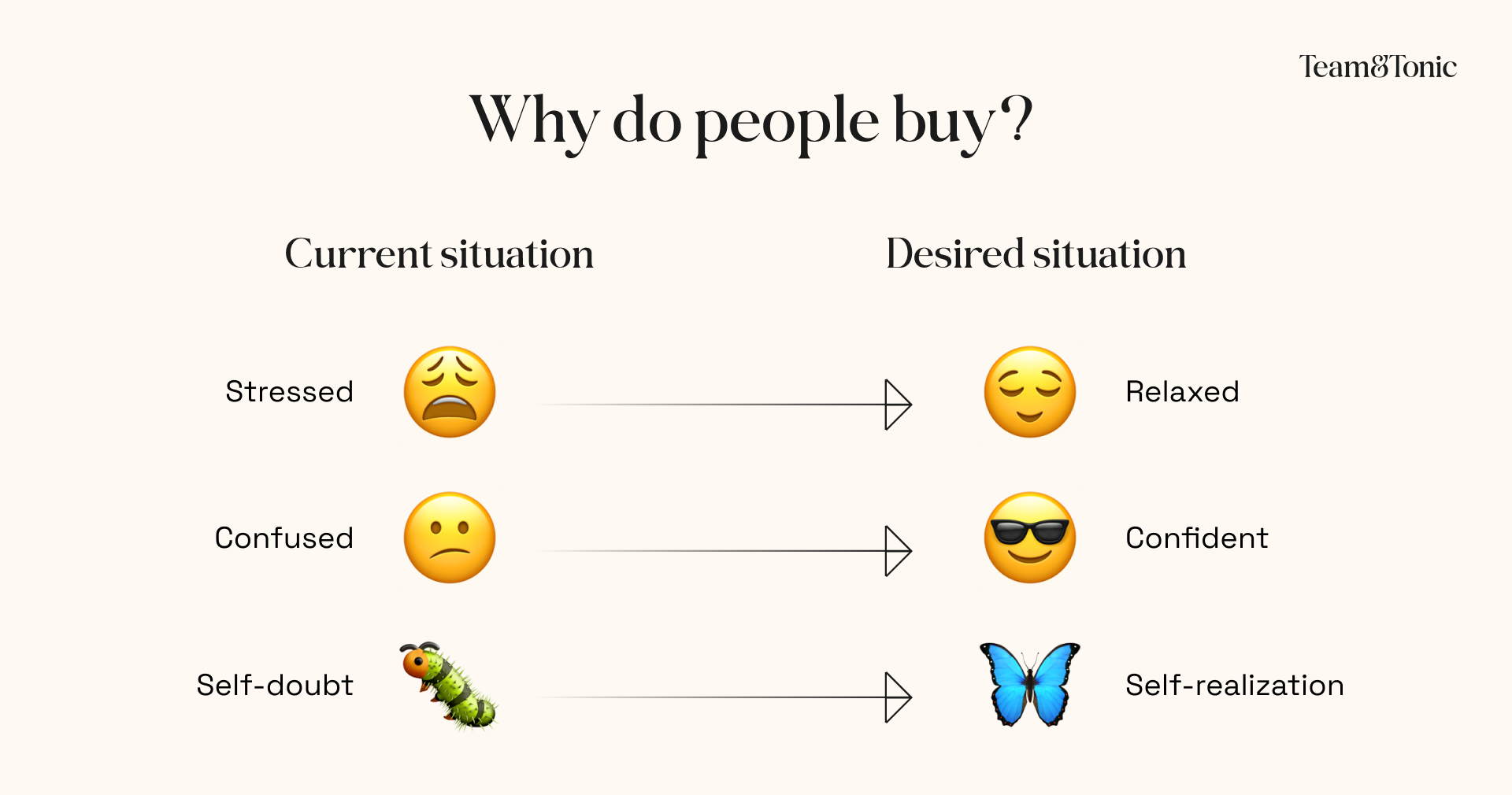
The space between those two points, their current state and desired state, is called the gap.
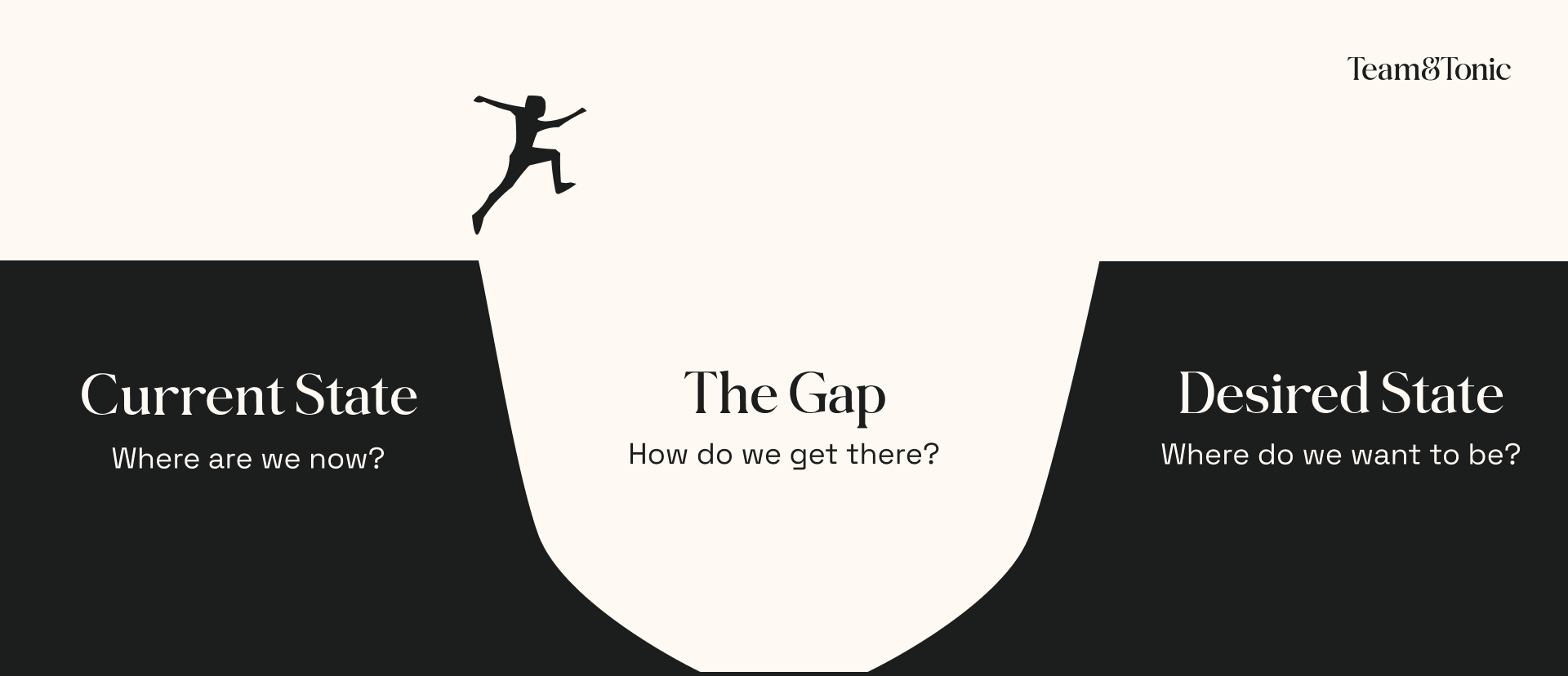
Therefore, your product’s job is to bridge that gap.
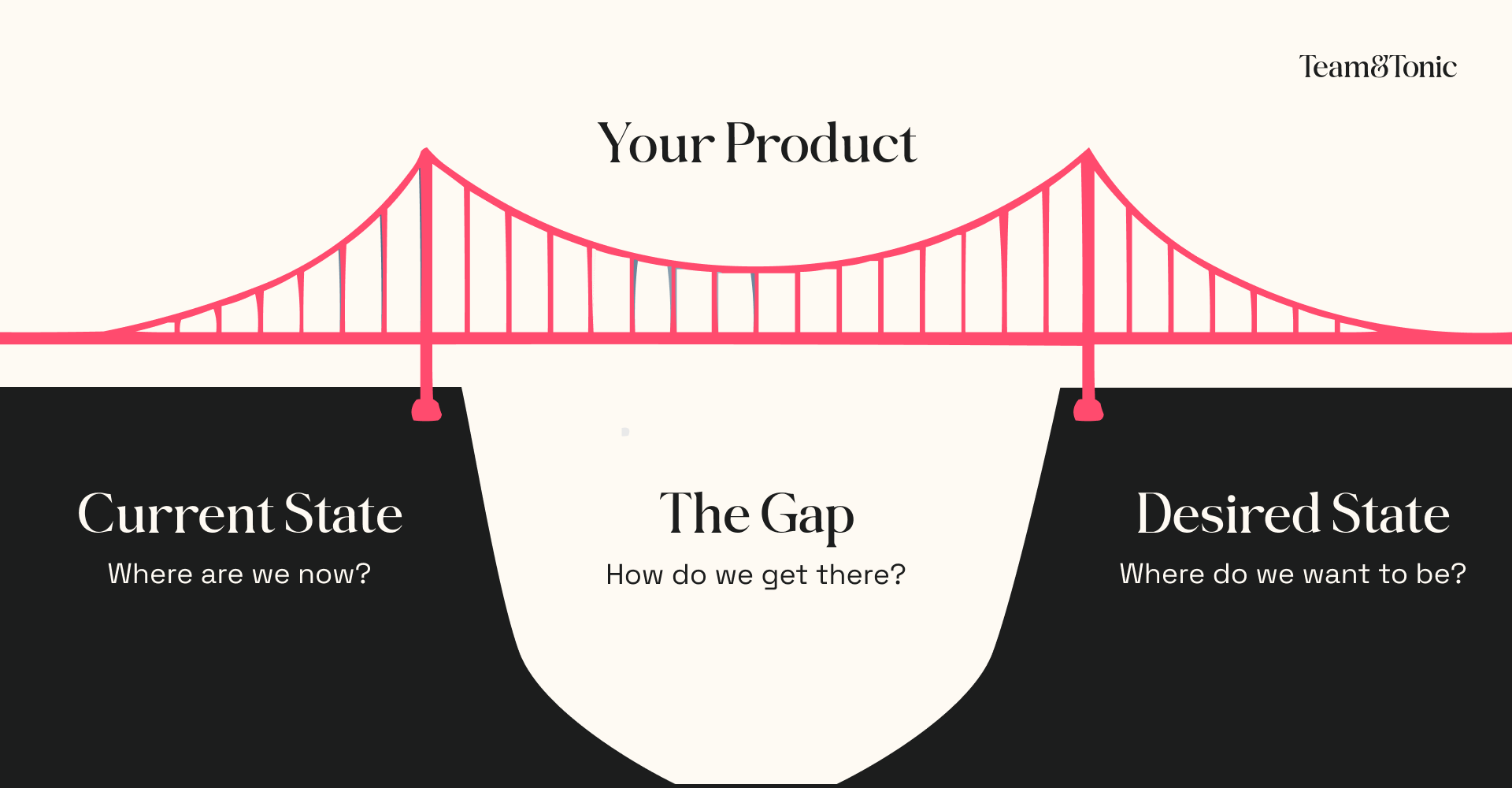
In my experience, there are only two ways to close that gap:
- Functionally. Through features, speed, price, convenience.
- Emotionally. Through meaning, identity, and connection.
Too many startups obsess over the functional gap. You’ve probably seen a lot of companies that obsessively talk about their product features and specifics, speed, or price. But even with a solid product and heavy marketing, they still struggle to connect.
Why?
Because people don’t buy for purely logical reasons.
Their desired state isn’t just practical. It’s personal. It’s emotional.
They’ve built a story about why they need to get to the desired.
And if your brand doesn’t connect with that story, you’ll lose them even if your product is technically better.
That’s why the real power lies in the emotional gap.
It’s what makes your product irreplaceable (not just a commodity).
How Do You Turn the Gap Into Revenue?
Customers buy with emotion and then justify with logic.
To understand how we can sell at scale, let’s reverse-engineer this concept. Starting with the most logical part which is when the customer gets to select the product (using their logical brain).
1. The product bridge. (logic-driven)
Let’s start with the most obvious: the functional need.
Let’s say I just moved into a new apartment.
It’s early morning, I’m half-awake, and all I want is a cup of tea.
I reach for the water kettle, only to realize… I don’t have one.
Current state: I’m standing in my kitchen, frustrated, unable to boil water.
Desired state: I want that warm cup of tea to start my day.
Bridge: A water kettle.
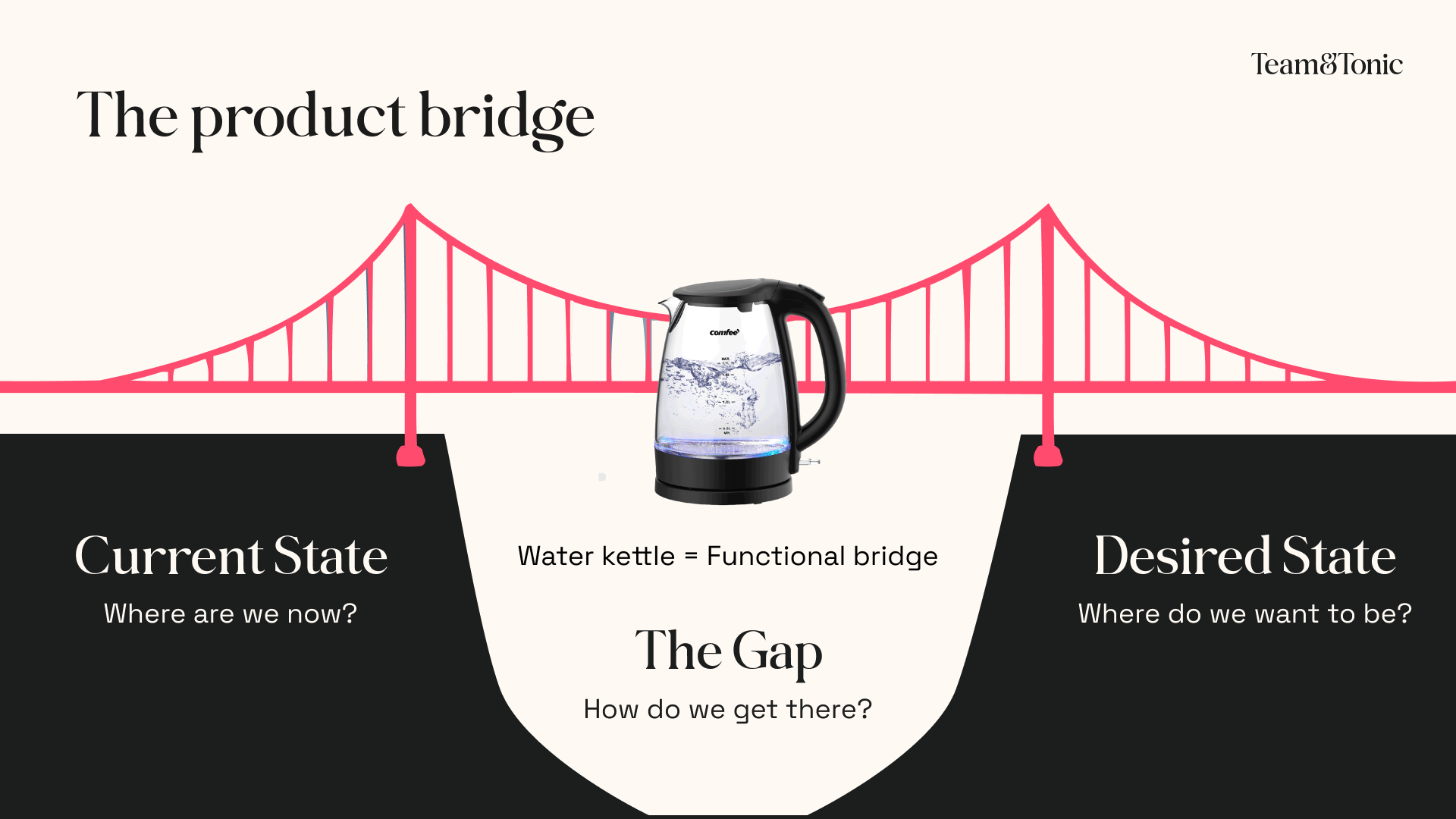
That’s it. The product helps you solve a straightforward, functional problem. It bridges the gap between where you are and where you want to be. Functionally.
Easy, right?
At this point the prospect is only aware that they need a water kettle. But as a company you want them to pick YOUR water kettle.
So before someone picks a product or service, they usually see some ads, a billboard, or maybe talk to a salesperson. Something or someone who helps them uncover not just what they want, but why they want it in the first place.
That’s where the emotional layer begins. So let’s dig deeper into that.
2. The sales bridge (logic + emotion)
If you've seen any sales training, you’ve probably encountered this framework before:
- Understand your customer’s current situation
- Clarify their desired situation
- Highlight the gap
- Position your product as the bridge
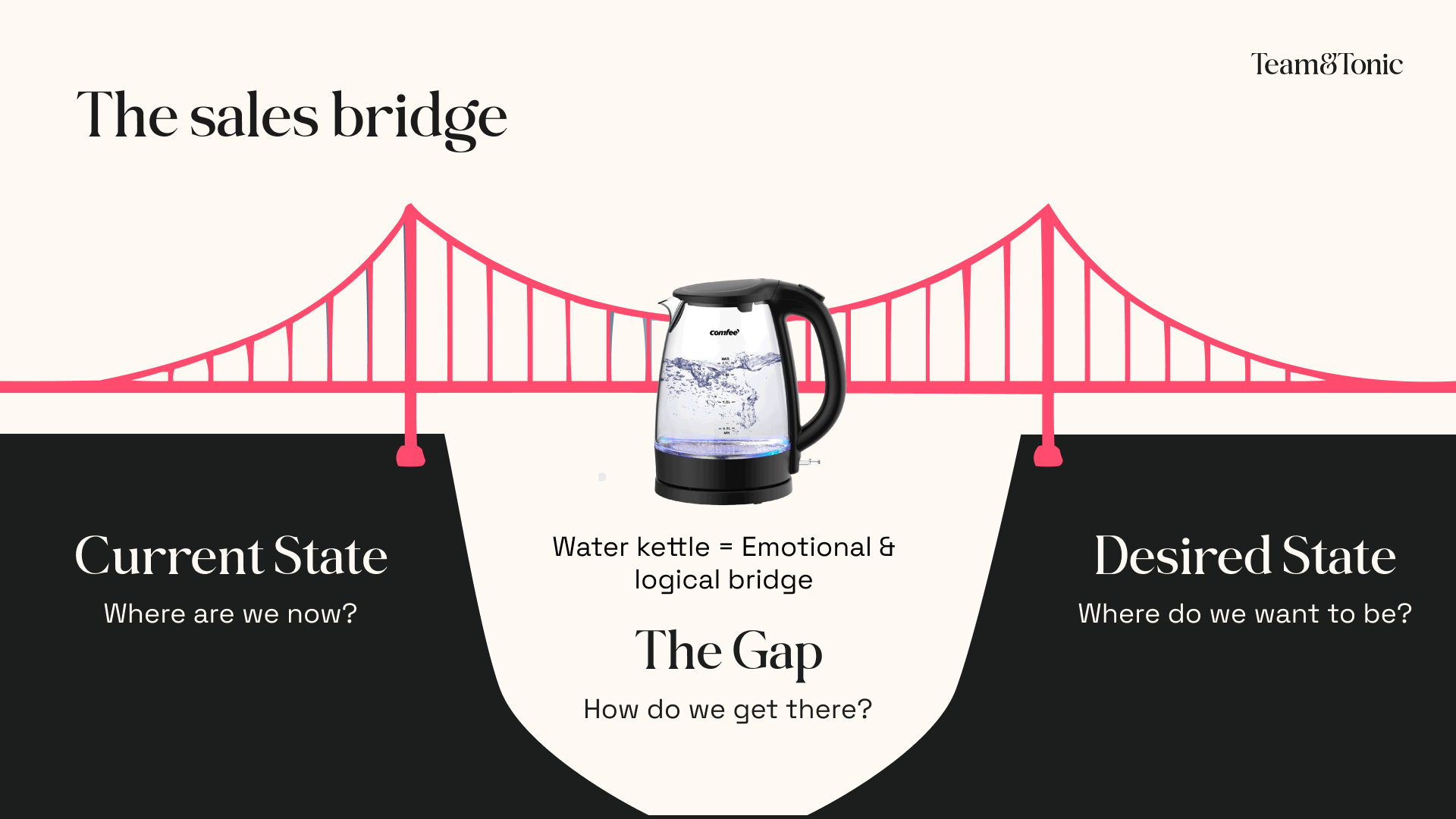
It works because it moves beyond features. It taps into motivation.
That’s why you’ve probably heard the phrase:
“The more emotional the buyer, the easier the close.”
That’s because you're not just solving a surface-level problem. You’re helping someone get to a version of themselves they want to be. And emotion drives that transformation.
That’s the power of great sales. It bridges logic and emotion.
But here’s the challenge: How do you scale that process… without talking to every customer?
Sales works beautifully one-on-one.
That’s where branding steps in.
3. The brand bridge (emotion at scale)
Take Apple.
Why do people line up at 3AM just to get a new iPhone?
Why do 92% of iPhone users stay loyal?
Why does Apple hold over 50% of the US smartphone market?
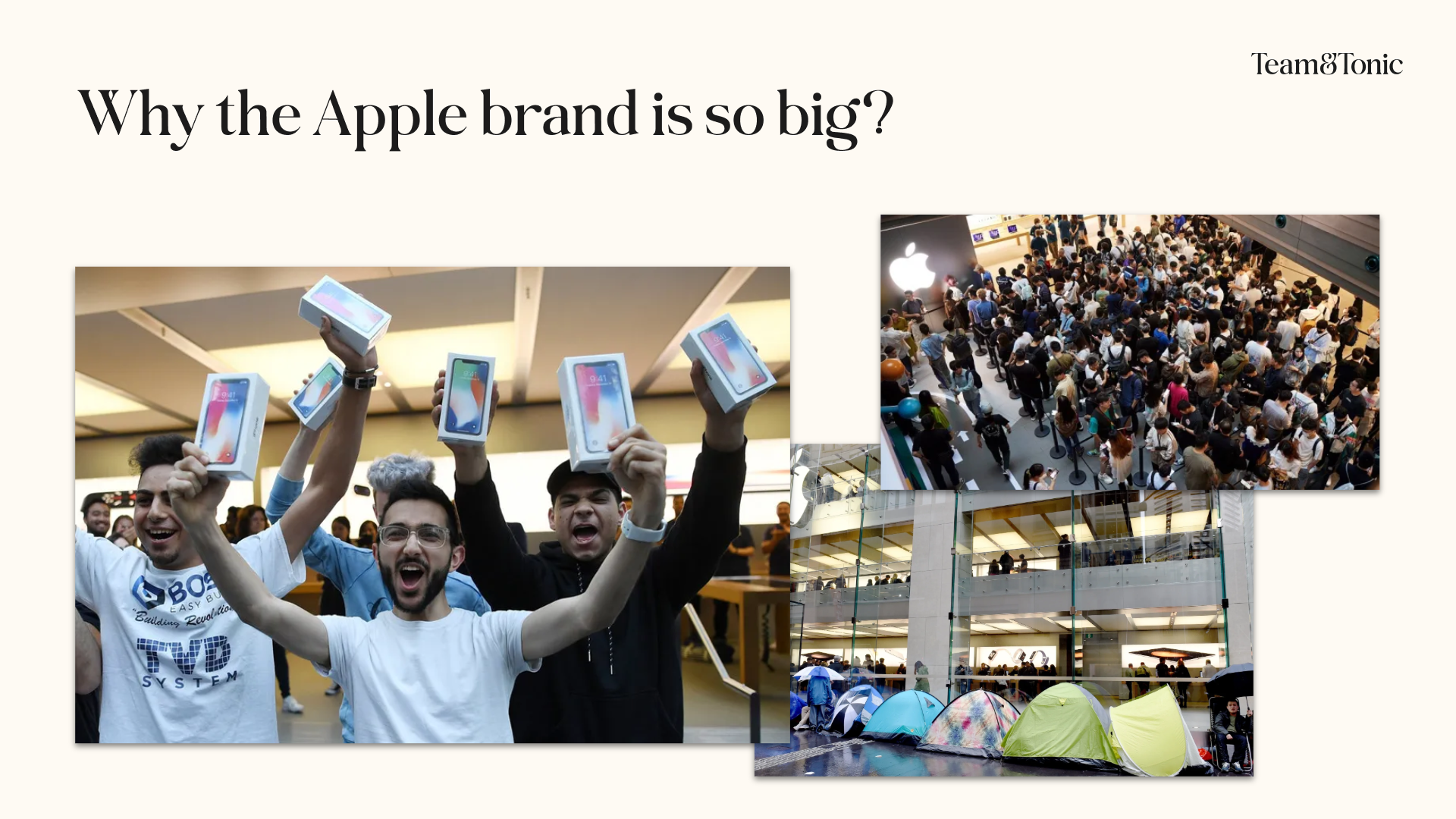
So what’s really going on here?
It’s not just the product.
It’s the feeling that comes with it.
Apple understands something most companies miss:
People don’t just buy products. They buy identities.
Here’s how Apple does this in practice:
Current state: I feel like I blend in. I’m just another face in the crowd.
Desired state: I want to feel bold. Unique. Like someone who thinks different.
Bridge: Apple’s brand makes me believe that by using their products, I am that person.
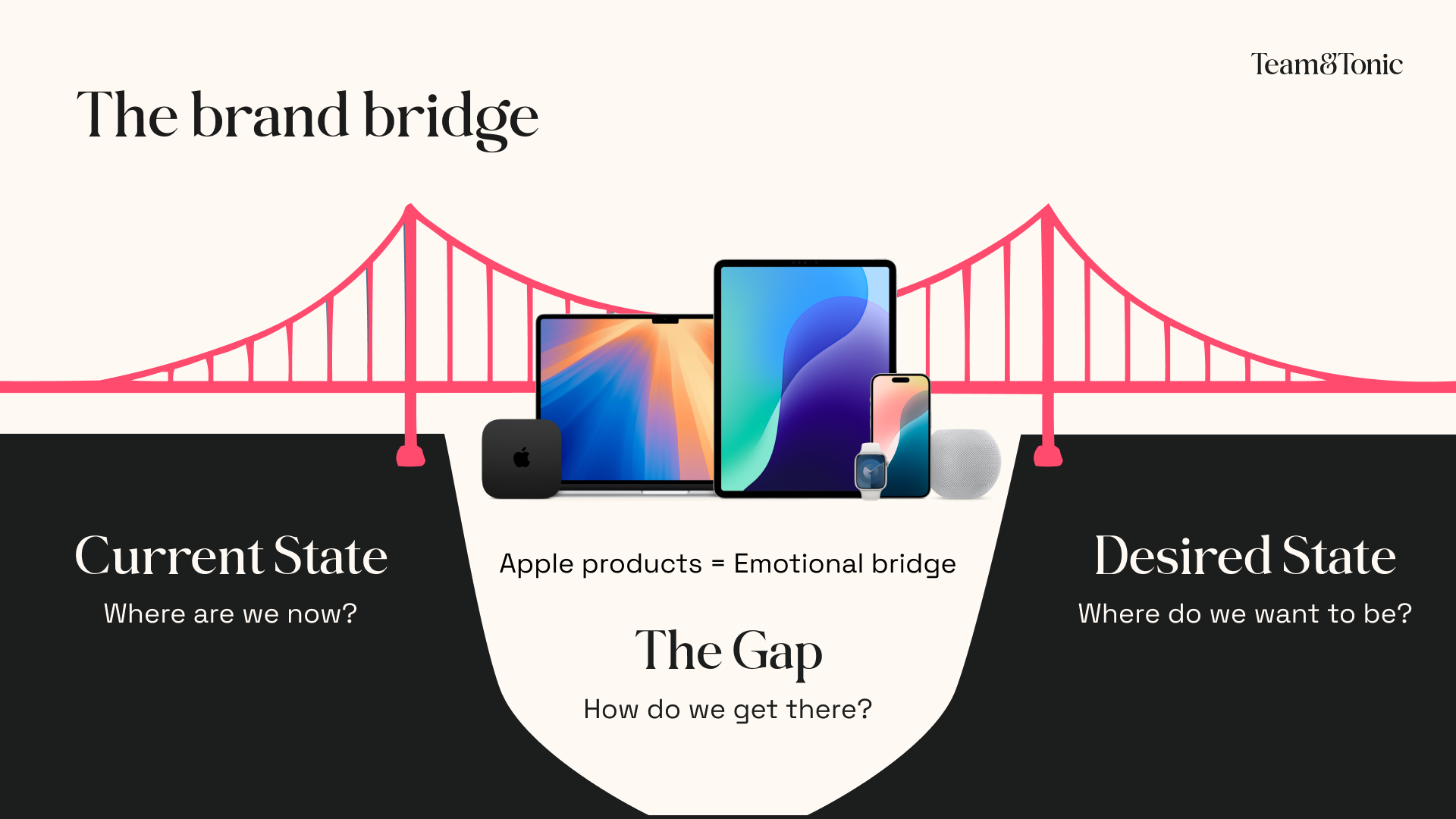
Apple doesn’t just sell phones.
It sells the belief that you’re one of the few who see the world differently.
And that’s what you’re really buying.
When a customer watches an Apple ad like this one, they’re not just seeing features.
They’re seeing themselves in the narrative. They’re aligning with a movement, they feel that they’re part of the misfits, the rebels, the creatives.
But let’s be clear that it’s not the “raw” product that makes people feel special.
They feel special because the brand makes them believe they are.
And this is how a brand bridges the emotional gap.
Important last thoughts.
You may have noticed that branding, sales, and product all follow a similar pattern:
They help the customer move from where they are to where they want to be.
So why are they so alike?
Because while as a company, you might think in terms of departments (product, sales, brand), your customer doesn’t.
To them, it’s one continuous experience. One journey. They’re just trying to buy a water kettle.
They don’t care whether it’s your product team, sales team, or marketing team speaking.
They just want to feel understood, confident, and ready to buy.
That’s why it’s crucial for your company to recognize the subtle differences between product, sales, and brand.Because when every part of the journey is aligned, emotionally and strategically, customers don’t just convert. They connect and stay loyal.
Brands sell day in, day out.
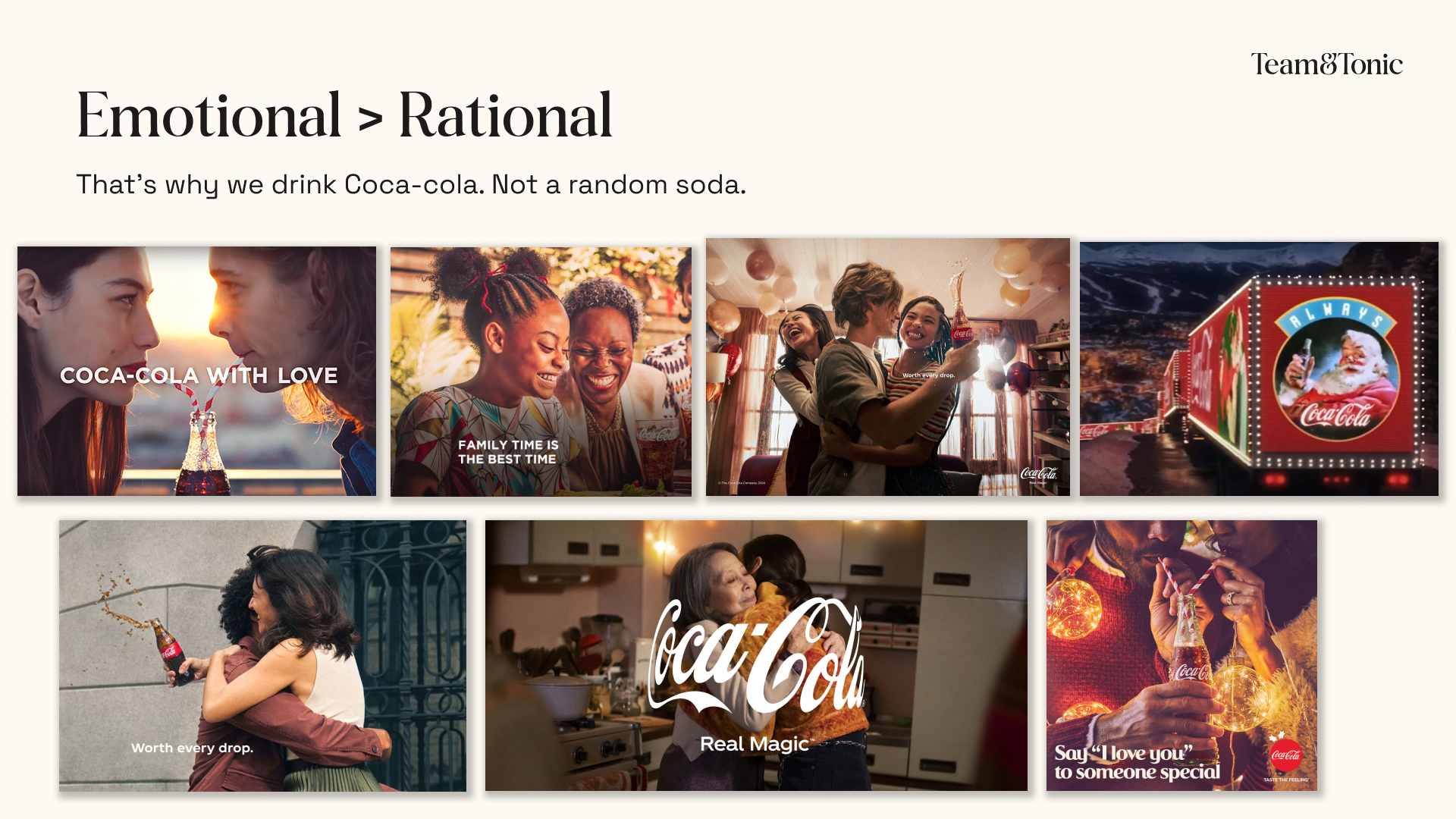
If buying decisions were purely rational, we’d all be drinking the cheapest cola on the shelf. Or just buying something way healthier.
But we don’t. We choose Coca-Cola. Again and again.
The power of branding is such that it even influences our taste.
At one point, Pepsi ran a blind taste test campaign to prove that their drink tastes better than Coke (check out this ad if you haven’t seen their blind tests).
And it worked. In blind tests, Pepsi won.
But out in the real world, Coca-Cola still outsold them.
Why?
Because people weren’t just buying a soda. They were buying what it meant to them.
That’s the emotional edge that can sell more than what you can ever sell with logic.
And believe me, I’m a very rational guy, so it took me a LOT of time to understand this.
That’s why the most valuable companies in the world don’t just build great products. They build great brands.
Because when you bridge an emotional gap, you create raving fans, you create communities, you create loyal customers, more people will buy, they’ll buy more and they’ll justify with logic later.
And the craziest part?
It doesn’t really matter if your product is better or not than the competition (but hopefully it is). Because in any case, if your brand is better, everyone will believe your product is too.
You probably know plenty of real-life examples like this.
One of my favourite examples is Domino's Pizza. You certainly agree that a traditional pizza restaurant is way better than Domino's pizza, right? (If you disagree with that… please message me. I need to know what pizza you’ve been eating).
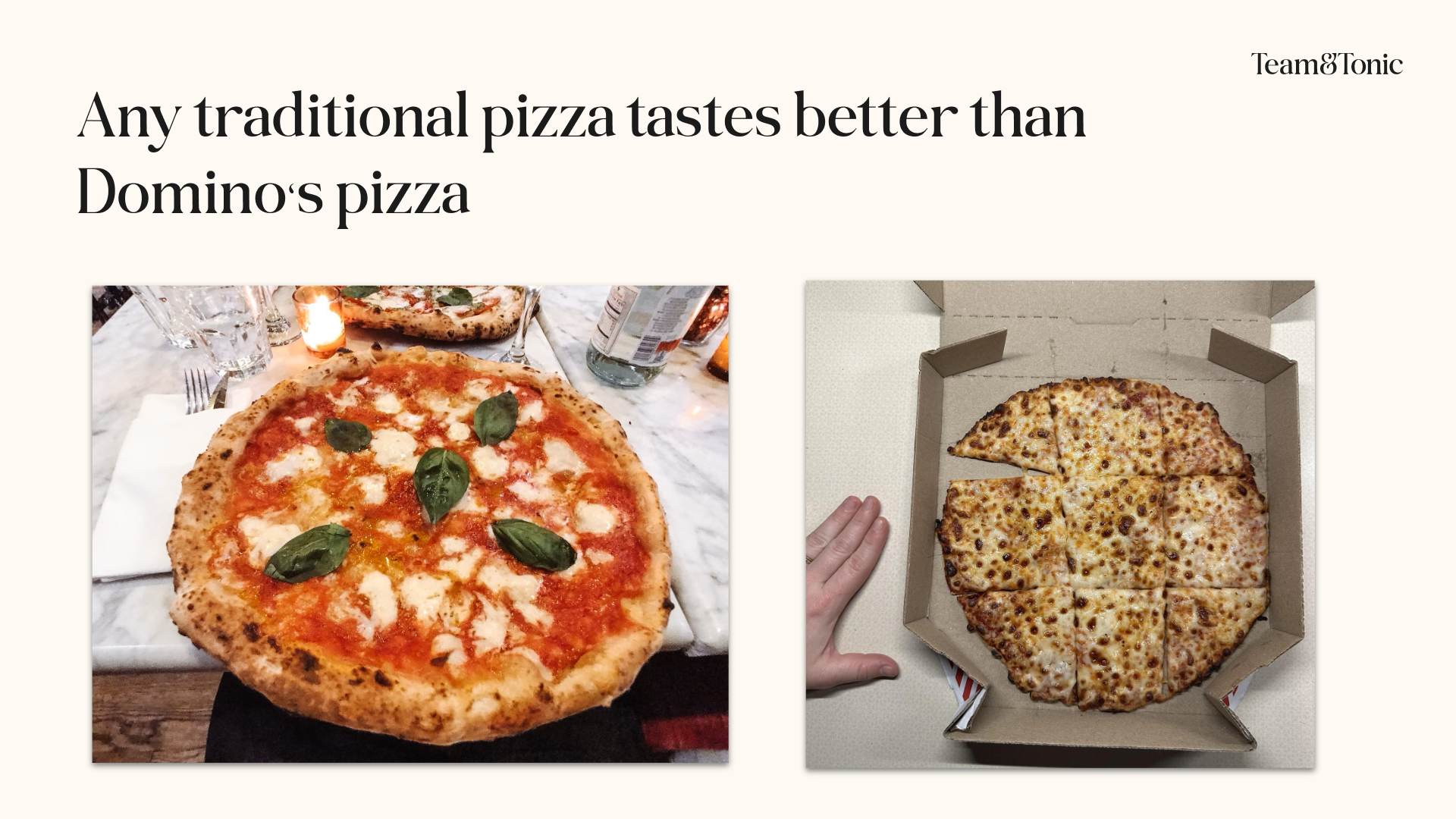
Domino’s pizza is far from good, they even went through a scandal that forced them to admit it themselves. (Yes, really, and they even made a campaign about it).
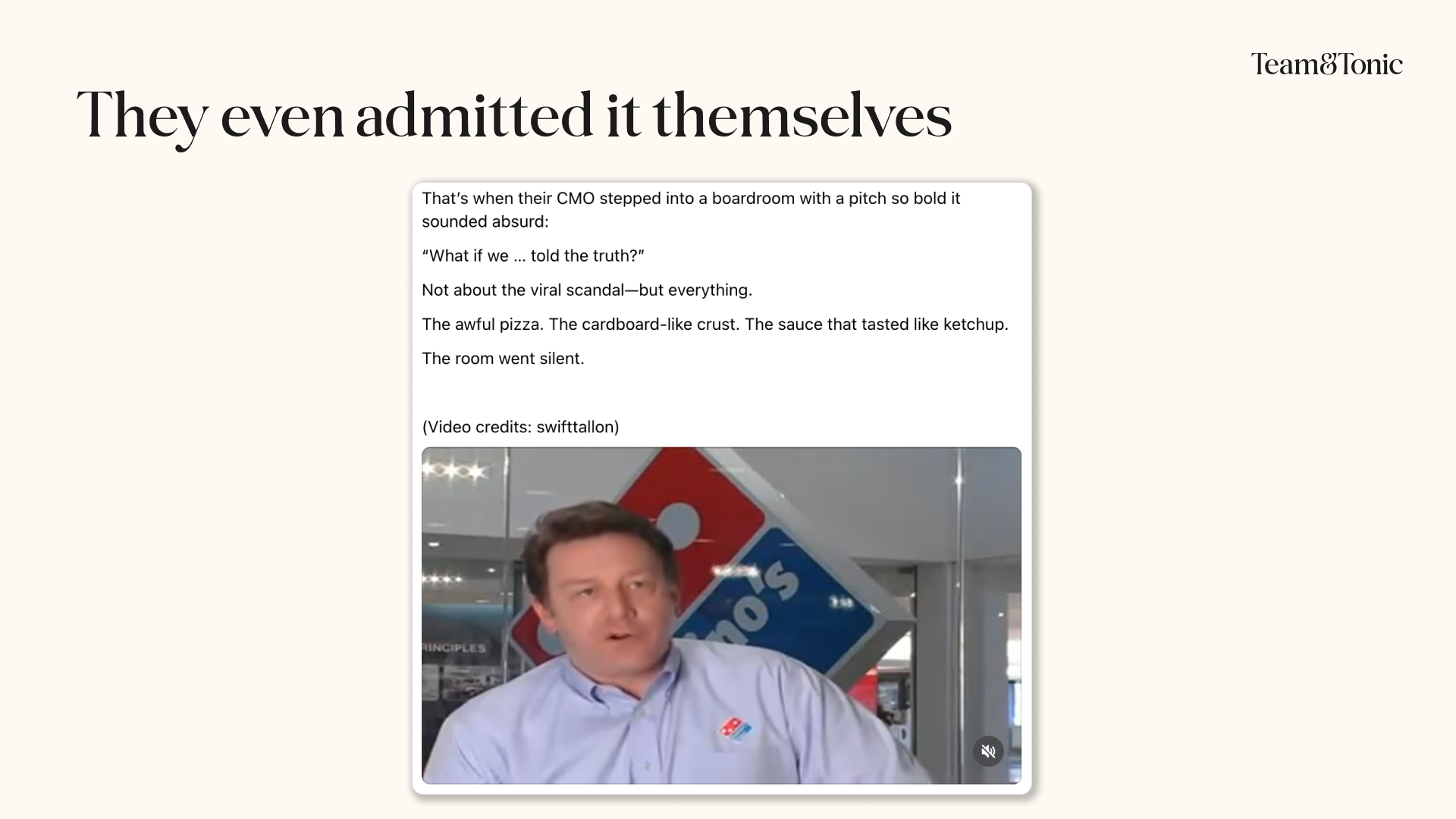
Yet despite the criticism and scandals… we all know Domino’s earns more than any local restaurant. (They earn so much and their stock is so strong that even Warren Buffett decided to invest in it.)
The thing is that Domino’s focus wasn’t on the product but on the brand.
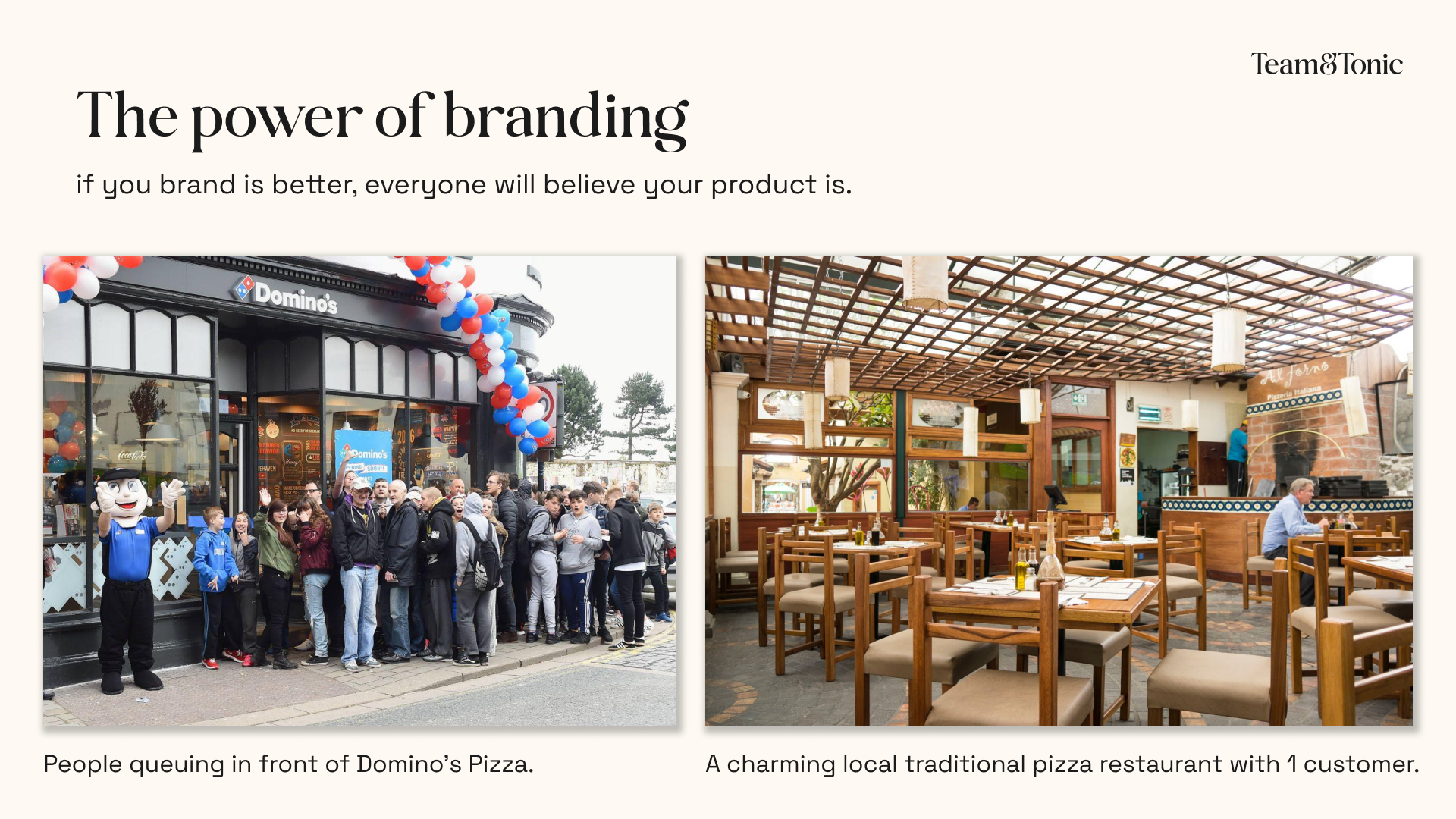
So if we’re all supposed to buy the best product… why does this keep happening?
Now, you’re probably wondering why some competitors outsell you… even when your product is clearly better?
Now you know.
It’s not just about being better.
It’s about being believed to be better.
And that belief is built by your brand.
So let’s fix that together.
The Growth Hack That Doesn’t Expire
Most startups think branding is about looking good. But branding isn’t what you say. It’s what people feel when they see you, talk about you, or remember you.
At its core, branding is a gut feeling.
It’s that millisecond impression that decides whether you’re remembered… or forgotten. It’s what makes someone stop scrolling, pause during a pitch, or remember your name in a crowded market.
And here’s the science behind it:
The human brain is wired for contrast.
People only notice what contrasts
Do you remember the examples at the beginning of the article about sneezing in Times Square vs in the library?
That’s exactly how branding works.
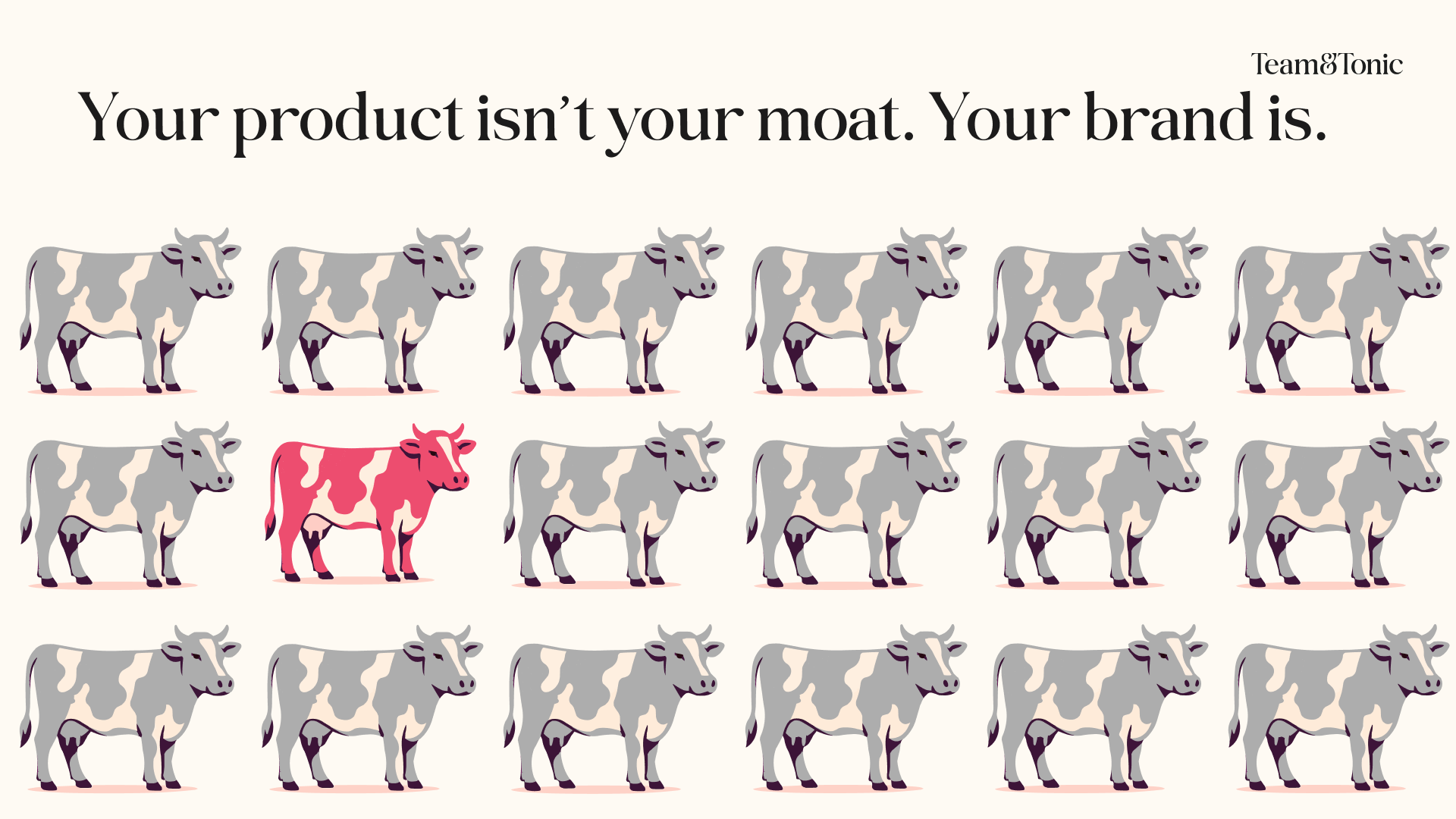
Most startups blend into noise. They pick nice logos, clean fonts, safe colors.
They copy what’s already out there and say that “We want something like Apple.”
But Apple didn’t copy anyone. Apple made noise in a quiet room.
In fact, if you copy Apple, you don’t build your own brand. You’re just reinforcing Apple’s brand, not yours.
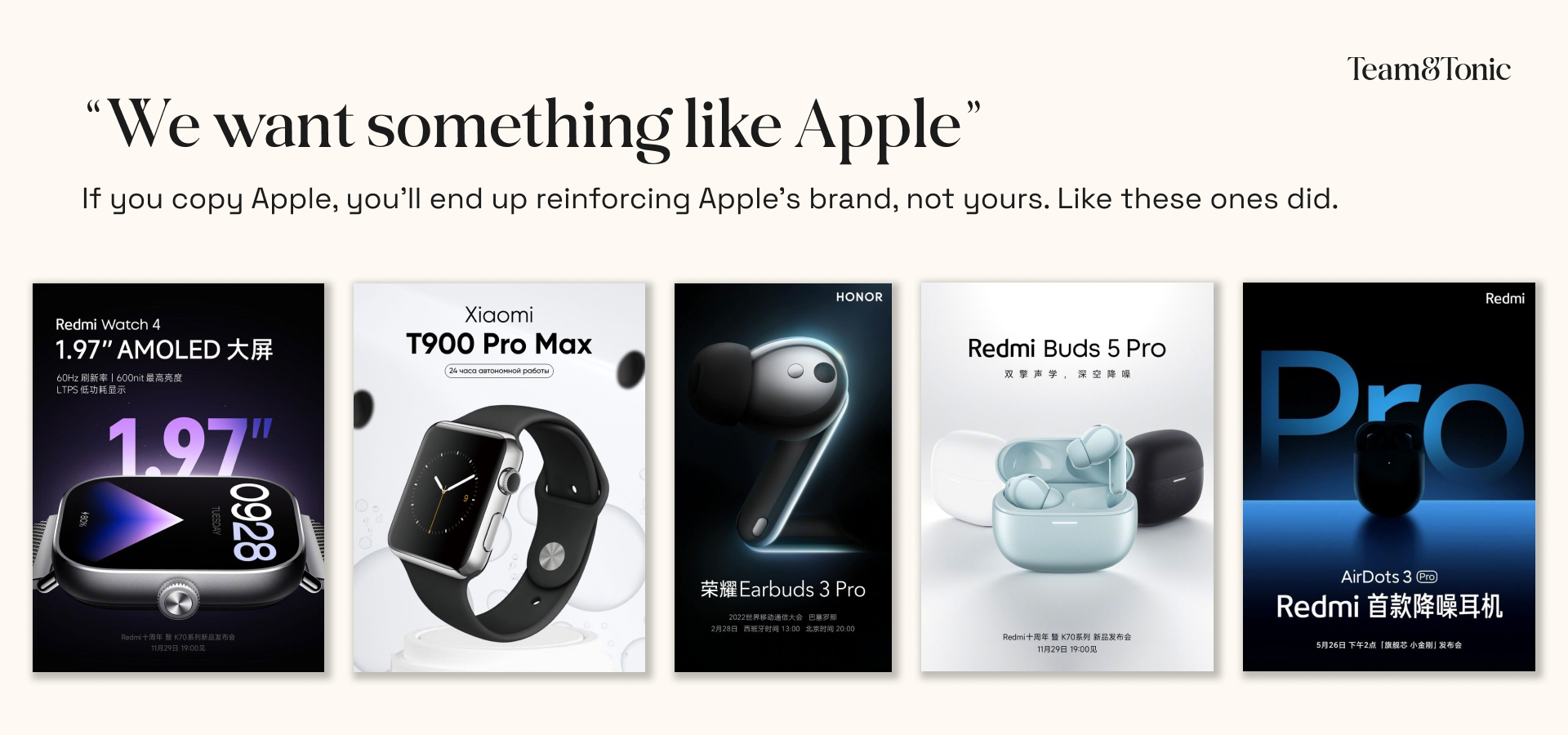
Your brand is how you show up
Think about yourself.
As a teenager, you thought that your outfit defined you.
But as an adult, you probably realize that it’s also your values, your beliefs, your energy, and how you behave.
We all go through the same evolution in our lives, and startups are no exception.
Early-stage startups obsess over logos, colors, and fonts.
But they forget the most important part: values, personality, consistency, alignment, tone, etc.
If you show no values, no tone, no alignment, no POV, no emotional spark, your customers’ gut feeling will be inexistent.
And no feeling means no trust.
That’s why most startups fade into noise, it’s just another sneeze in New York.
So remember that branding is not your logo. Logos, colors, fonts are just clothes. Those clothes are part of your brand but your brand is larger than that. Your brand is the personality wearing those clothes. It’s your values. Your tone. Your conviction.
That’s what resonates. That’s what sticks.
Why does it matter for startups?
Because startups tend to chase the next hack: looking for the next viral post, the next Facebook ad playbook, the next cold DM template that might unlock a wave of conversions.
And sometimes, those hacks work. For a while.
But every hack has an expiration date.
However, brand doesn’t expire. It compounds.
It makes every channel work better.
Ads convert better.
Emails get more replies.
Investors return calls.
Candidates say yes.
That’s the hidden force behind companies that scale fast and last long. A great brand:
- Reduces CAC
- Increases LTV
- Boosts retention
And the good news?
You only build it once, and if you do it right, it pays off forever.
{{banner}}
Now, Let’s Talk About YOUR Brand
I won’t go into details that should be handled by creative directors or designers.
So we won’t talk about brand theory or design aesthetics.
Instead, I want to discuss the fundamentals that will drive business results.
I only want to give you the information you truly need to set very strong foundations and then work with a professional who will help you build an outstanding brand.
Building a brand is like building a personality. It has:
- a goal (helping the customer bridge the gap)
- a job (positioning)
- a voice (messaging)
- a look (identity)
- a behavior (consistency).

1. Your bridge
Your product exists to take your customer from Point A (current state) → Point B (desired state).
But to make your brand meaningful, you have to understand:
- What is their current situation?
- What is their desired situation?
- What’s preventing them from getting there? (The gap) What’s the story they have created?
- How will you bridge that gap?
You can first do it from a logical point of view and then from an emotional standpoint.
2. Your positioning
Positioning is your brand’s job description. It defines the market you play in, it sets you against the enemy you fight, and positions the promise you make.
Without clear positioning, your audience won’t know where to place you in their mind. And if they can’t place you, they won’t remember you.
This is not to be communicated externally but to get clarity for yourself first.
So let’s fill in this positioning sentence:
At ________ (YOUR COMPANY), we help ________ (IDEAL CUSTOMER) achieve _______ (DESIRED SITUATION) by ________________ (BRIDGE - OFFER) and without _________ (GAP - PROBLEM).
For example: At Team&Tonic, we help AI & tech startups scale by working with the best 0.8% of freelance designers and marketers without hiring hassle, management headaches, or disappointing results.
3. Your messaging
Great messaging makes people feel understood. It shows you get them, and that creates trust.
- Highlight Unique Selling Points (USPs): Emphasize what makes your brand stand out.
- Example: Team&Tonic is an exclusive vetted network of the best 0.8% designers and marketers, providing end-to-end support from hiring to project management and delivery.
- Focus on benefits, not features: Explain how your product solves a problem or improves the customer's life.
- Example: With Team&Tonic, you can save time, help you focus on your business, get high-quality work delivered fast, get the right expert for every task, and request any freelancer within 72 hours.
- Use data to build credibility: Incorporate statistics or specific achievements to substantiate your claims and establish trust.
- Example: We only work with the best 0.8% and we have vetted over 120,000 candidates.
- Maintain consistency: Ensure all key messages align with your brand’s overall mission and values. Each message should support and reinforce the others without contradiction.
- Simplicity and clarity: Keep messages straightforward. Avoid jargon or overly complex language to ensure clarity and accessibility.
4. Your identity
Your logo, colors, typefaces, and photography style should embody your positioning and tone.
This should be handled by a brand designer and I urge you to work with a great one.
The most important piece of advice I can give you for this is to create a strong association that will help people remember the name of your company.
Why? Because customers remember images and colors more than they remember names. Therefore if your brand identity triggers your name, you’ll make it easy for them to find or refer you.
That’s why the visual identity of Team&Tonic was tied to the one of gin & tonic. We put cocktail glasses everywhere to reinforce that association (yes, it’s even in our logo!).
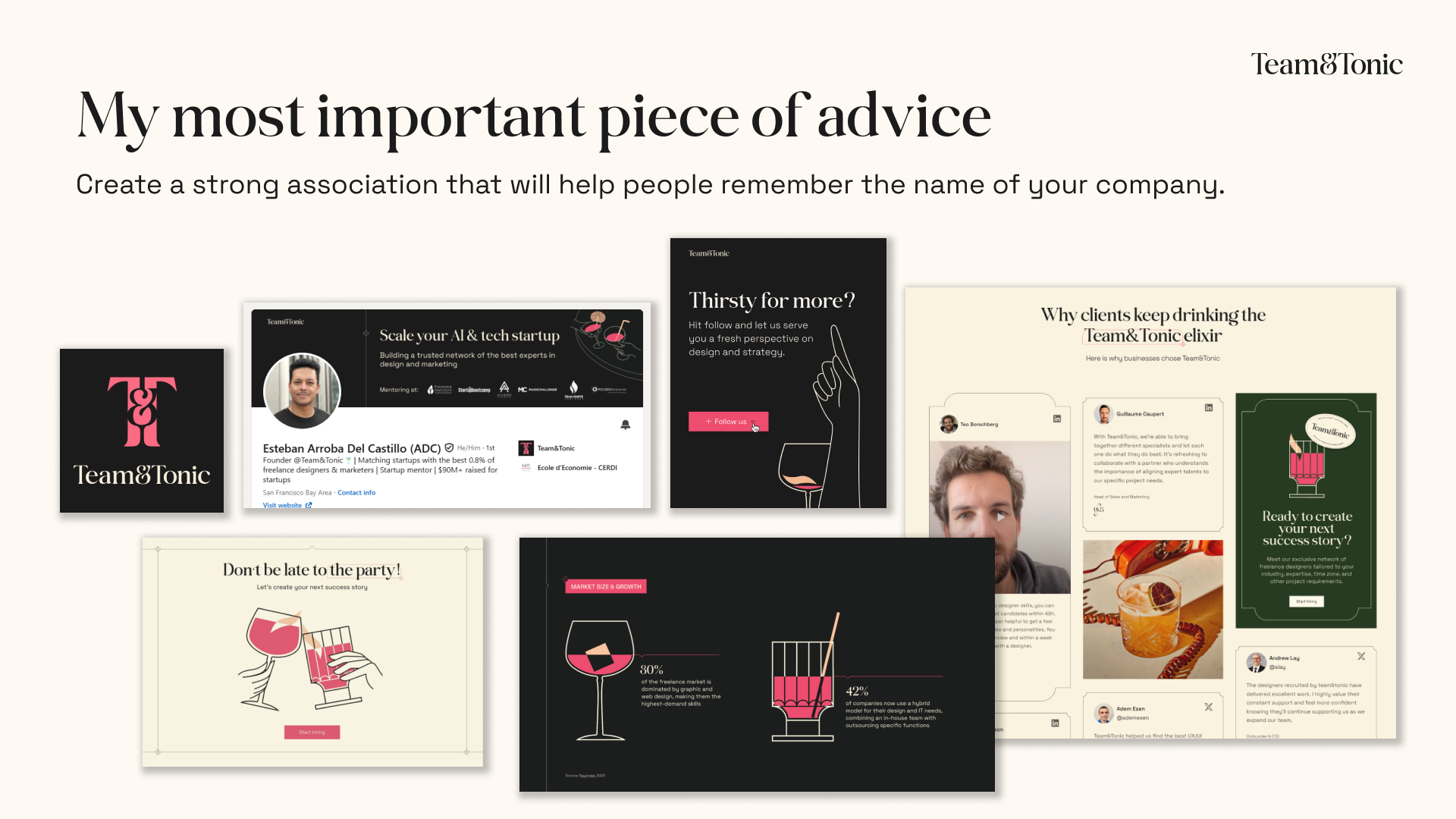
5. Consistency & Alignment
Inconsistency kills trust.
A brand must exist across your entire business: website, deck, emails, product, ads, social, even customer service. Help customers to remember you.
If you constantly change tone, visuals, or messages across touch-points, they won’t know who you are or worse, they’ll stop caring.
Brands that win are ruthlessly consistent.
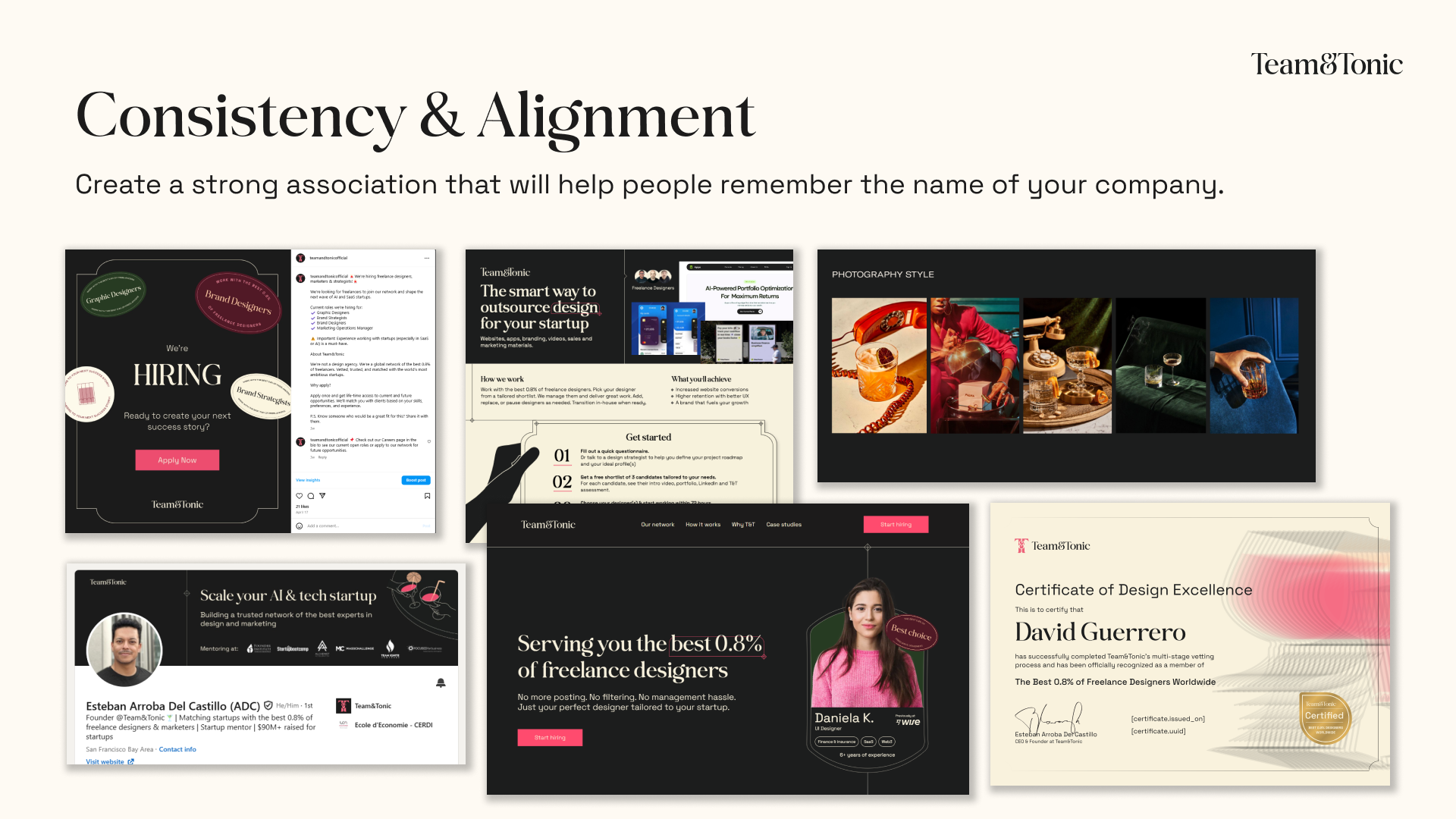
If you want to dig deeper into branding, here are my favorite books.
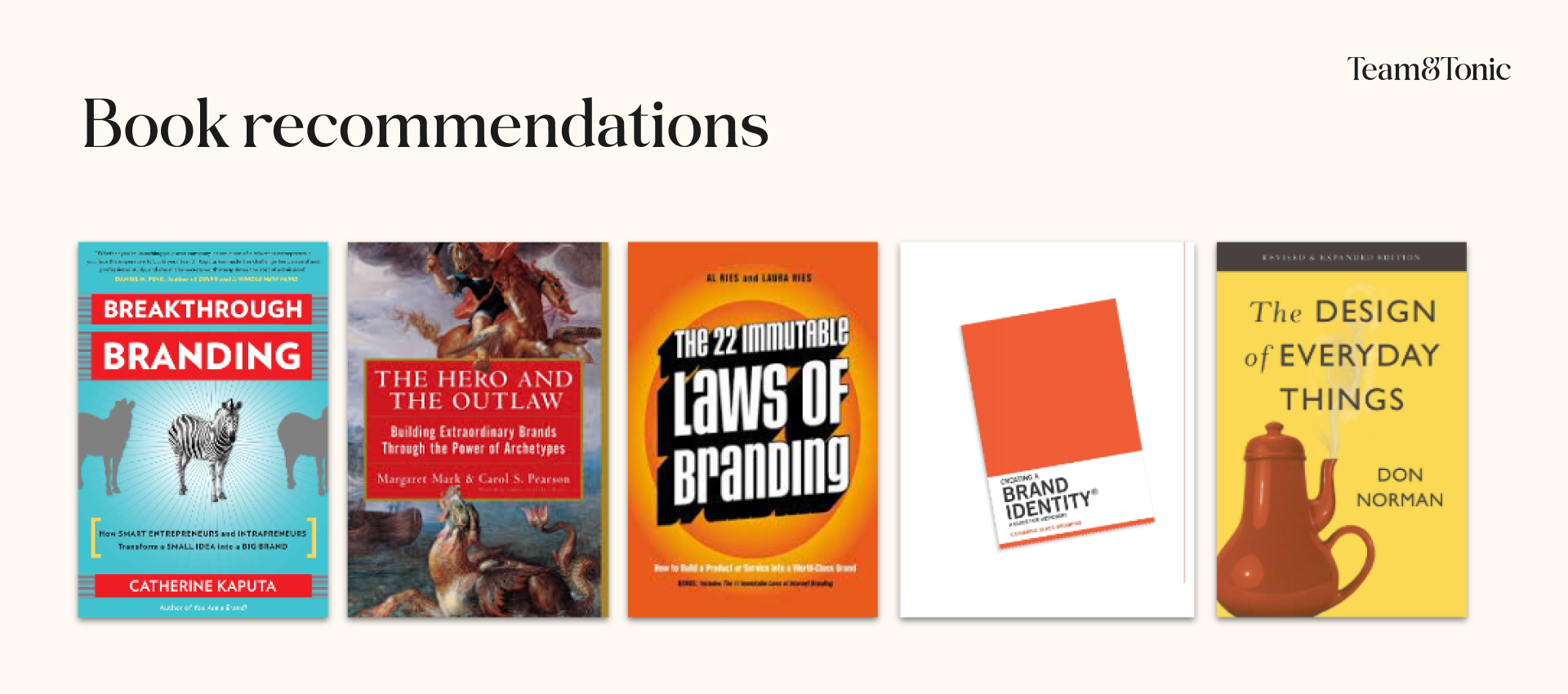
And if you want to expand your knowledge beyond branding, I recommend these 3 books on positioning, storytelling, and UX to complement branding.
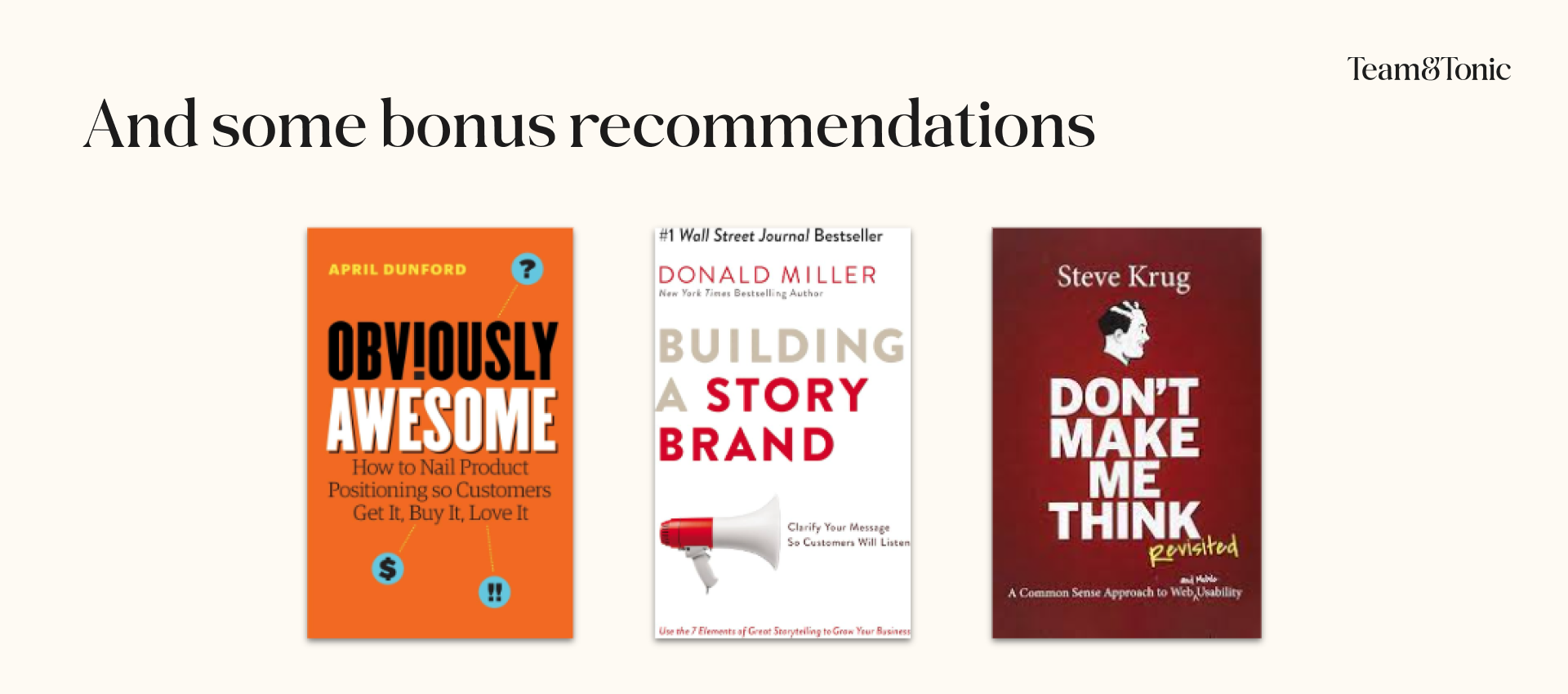
A word of caution
Before you dive in, there are two things you need to understand.
1. You don’t iterate on a brand. You create it once, and you create it well.
A brand isn’t a feature. It’s not something you A/B test or tweak like a landing page.
It’s the soul of your company: your beliefs, your tone, your point of view.
If you copy someone else or change it too often, trust decreases.
Yes, your brand can evolve, just like people do.
But its core must be unshakable:
- What you stand for
- How you speak
- What you never compromise on
- How it looks and feels
Think Apple, Nike, Stripe. Their products have evolved, their messages have been adapted, but their core is timeless.
Founders who “iterate” on brand are usually doing one of two things:
- They didn’t work with the right person to help them define it in the first place
- Or their team is chasing trends instead of standing for something. But that’s not branding. That’s confusion.
A brand should build clarity. Because clarity builds trust. Trust builds conversions. And conversions build growth.
2. 99% of creatives don’t understand the relationship between branding and business
After interviewing 300+ creative directors and even more designers, only 3 people could clearly explain how branding ties to business outcomes. Let that sink in.
Yes, you heard that right. 99% of creatives won’t tell you how a brand contributes to your business or boosts your sales.
That’s because they’re mostly interested in aesthetics, they about talk fonts, colors, and vibes.
But almost no one can tell you how a brand reduces CAC, drives conversions, or increases LTV.
If you don’t believe me, I invite you to ask these 3 questions to a brand designer and even a creative director:
- How can branding boost my sales?
- Can it lower my acquisition cost?
- What’s your process, and how does it drive business impact?
Most will give you vague answers.
Since a real brand makes selling easier, builds trust before the first sales call, attracts the right customers, repels the wrong ones, increases perceived value, and lowers friction so your funnel converts better.
You need someone who thinks like a founder, not just a designer. Someone who understands your market, your positioning, your customer behavior, and turns that into brand strategy.
And unless you know what to look for, you’ll hire someone who’s just decorating the surface.
Which is why I’m sharing this knowledge with you.
Now that you know the biggest pitfalls to avoid, let’s dive into how we can actually do it right.
Next Steps
Let’s look at improvements you can implement right away.
If you have a brand
Let’s test it now:
- Can your team describe your positioning in one sentence?
- Do your customers feel like you “get them”? Do they remember your brand long after they started working with you?
- Has your sales team noticed potential clients remember the brand, compliment it, or feel it reflects them?
- Can people recognize your brand without the logo?
If you struggled to confidently answer yes to any of these, it might be time to bring in an expert.
{{banner}}
At Team&Tonic, we help startups build unforgettable brands by connecting them with the best 0.8% of freelance designers and marketers.
You’ll get access to elite designers, like Creative Directors, Brand Designers, Graphic Designers, Illustrators… and more.
We’ve vetted over 120,000 candidates and review hundreds more daily. Why? Because finding someone who truly gets your company and can create a visual and verbal identity is hard.
That’s why we decided to make it easy.
Whether you’re building your brand from scratch, need additional brand assets, or want to bring your freelancer in-house, we’ve got you covered.
Just tell us what you need, and we’ll match you with the right designer within 72 hours.
(For reference: hiring this quality level on your own would take ~2 months and a full recruiting team. We cut that down to 3 days.)
If you don’t have a brand
Now’s the time to build one.
The sooner you start, the better, because a brand compounds over time. It makes people notice you, trust you faster, and honestly, it makes your whole team’s job easier when it comes to any marketing activities and design.
Let’s start here:
- Define your customer profile. Who are you talking to? What do they want most? What do they fear?
- Clarify your positioning. What’s your one-liner and why are you different?
- Choose your brand values. These will guide how you speak, design, and act. Write 2–3 short paragraphs that resonate with your team and audience.
- Craft a simple visual system. Just enough to look intentional: colors, fonts, imagery style. Don’t overthink it.
- Write your story. One paragraph: Why you exist, what problem you solve, and how you’re different.
To get clarity on these questions, you may want to be advised by an expert.
You can get early access to the Startup Mentor Matching at Team&Tonic.
You get direct access to incredible startup CMOs and Creative Directors for just $50/month (only during beta!).
They’ll audit your actions, bring clarity, and help you design a growth system that actually works.
That price is a total steal to get access to incredibly talented people who have helped startups day in, day out.
So there’s no excuse not to get clarity on your brand.
Join our newsletter to get our latest insights
Related Articles










